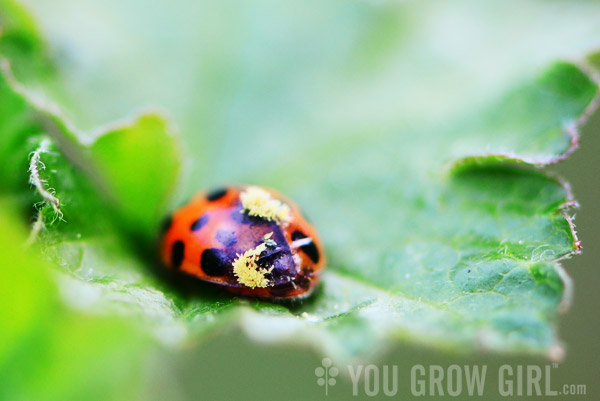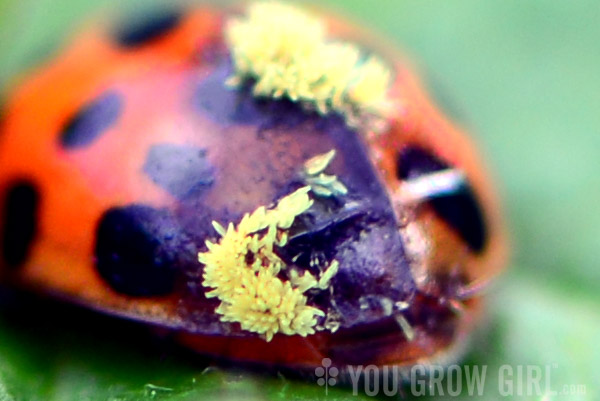
The other day, while walking around, exploring the garden, I happened upon a ladybug sitting on a leaf on the black currant bush. Upon first glance I thought the ladybug was alive, but looking more closely I could see that it was unmoving and probably dead. Next I noticed a bruised, wet spot on its back, and moving in closer still I could make out two clusters of tiny, cream-coloured shapes emerging from out of it. I was not able to tell with the naked eye whether the things on its back were eggs or tiny larvae, so I quickly ran inside to grab my camera with macro lens. What I saw when I was able to go in close is like something out of a B horror flick. The ladybug had been parasitized, most likely by a wasp and the things on its back were the eggs. Blow up this scene to human scale and the potential for an all too real monster movie practically writes itself.
Spring is here and the garden has come alive. A new flower is blooming just about everyday. Leaves are unfurling. Insects and pollinators are returning. The overall colour palette has transformed from pallid brown to vibrant green in just a matter of weeks. Stepping out into the garden each day to observe the changes that have occurred quite literally overnight has brought a new energy and vibrancy to life. Finding this parasitized ladybug was a reminder that the garden is not just a ferociously happy or even benign place of beauty. We try to affix ultra positive, overly simplistic messages to it, perhaps because we are frightened and need to believe in safe and carefree fairytale lands (perhaps more-so now than ever). The garden is a part of the world, and if we look beyond the surface we can see that terrible, frightening things happen there too.

However, just as life in the garden is not all sunshine and roses, it is not all terrifying, microscopic monsters and horror movie fodder either, but something more complex that lies in between. If we cultivate awareness and allow ourselves to take it all in (not just the nice stuff), a garden can serve as a bridge, a place to work into and through the light and darkness of the world. In that way it is more or less a fairytale land, but one where the heroes and villains aren’t so easily defined (because nature is not evil or malicious) and the ending isn’t so much happily ever after because there is no beginning or ending.
It just is. Breathe in, observing the breath as it comes in. Breathe out, and watch it leave.
Was just thinking of you the other day, wondering how your health was. So good to get your terrific post.
Thanks for thinking of me Sharon. I’ve been quiet here because I needed to put everything I could into completing the book.
Nice one. When I think of bugs being parasitized, for some reason, I always picture big juicy pests such as tomato hornworms.
Makes sense — they are commonly parasitized.
Amazing, both the thoughts and the pictures.
And nice to hear from you again :]
Thank you
A couple years ago, I kept finding ladybugs in my house with the exact same fuzzy yellow stuff on them. For some reason I thought it was a fungus!
Wasp might be beneficial?
I’m pretty sure that this ladybug is the invasive 16 spot Asian ladybug. Hopefully more of them will become parasitized. If they overwinter in your house, yup….they are the Asian invasives.
I love this post, Gayla. You’ve conveyed it beautifully that it’s not all lovely and gorgeous all the time. These kinda reality checks are essential in our rosy-social-media-led everydays!
“Finding this parasitized ladybug was a reminder that the garden is not just a ferociously happy or even benign place of beauty.”
Yes indeed. My grandfather once said “folks like to get away in nature, and remark how peaceful it all is. Well, if you look closer, it’s clawing and fighting all the way down to the microscopic level.”
Good post, Gayla.
Thank you for the perspective and insight. Hope you’re well.
Exceptional photo!
Can’t wait to see your new book.